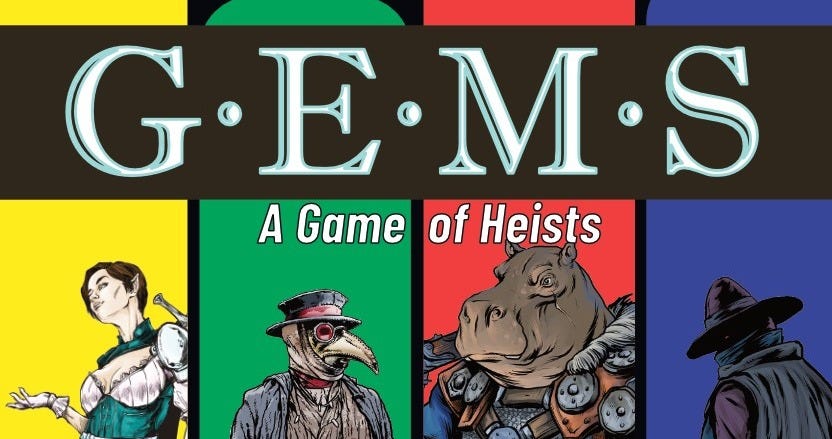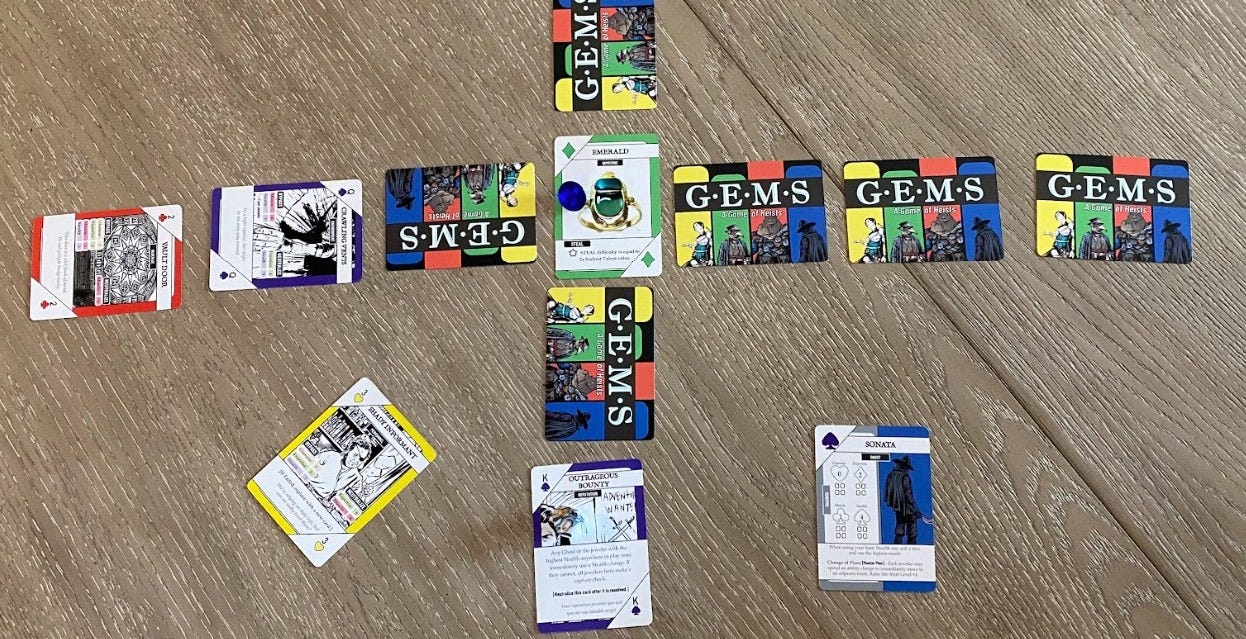Our first Design Diary is a breakdown of my most recent game, G.E.M.S. - A Game of Heists. The game was released on DrivethruRPG on April 1st, 2024. It was followed up with a physical and Print-n-Play card deck on September 6, 2024.
“GEMS is a cooperative role-playing game for one to four players. Each player takes the role of a jeweler, an elite thief with specialized talents and abilities, as they embark on heists to steal the various magical Gemstones from the strongholds that guard them. Navigate guards, traps, barricades, and other security measures to steal the jewel and free its stronghold from its power.”
G.E.M.S. 20% Newsletter Discount
G.E.M.S. card deck 20% Newsletter Discount
Origins
G.E.M.S. was created as part of DrivethruRPG’s 2024 PocketQuest challenge. Beginning in 2022, DrivethruRPG has hosted an annual game design jam called PocketQuest, which challenges designers to create a game of 24 pages or less in the timespan of about 2 months. Each year features a new theme that the game must adhere to, though the interpretation can be quite broad. This year’s theme was “Heists.”
The title of the game came first: “GEMS!” is a battle cry my gaming group shouts out constantly whenever we play any game with loot to collect. Whatever game I created, I wanted it to get players to shout that out as they claimed their prize.
I then thought of some of my favorite heist media: Ocean’s 11, Mission: Impossible, Inception, Firefly, Persona 5. I knew immediately that I would want my game to capture the feeling of planning how to move through a heavily guarded facility, working together as specialists with a unique set of skills, and a target to steal that was both unique and would complicate everything once obtained.
Structure
One of my favorite types of heist sequences in media is the speedrun to the prize, as the thieves use their specialties one-by-one to take down an ongoing string of more and more complicated traps and security measures. In order to have that sequence at its core, I built G.E.M.S. around the set-up of a map or board layout filled with hidden/unrevealed encounters to surprise players. It was important to me that the game also be playable without the role of a Game Master for multiple reasons: to allow the game to be played solo, to keep the feeling of suspense and surprise for all players, and to allow for some chaos when things don’t go as planned. I could accomplish these goals (map full of surprises and no GM) by using a deck of cards to create the map. I originally looked at the Carta SRD as a possible foundation for the game, and though I didn’t use it, it ultimately inspired the system I developed.
Having “GEMS” as the title, I wanted the concept to factor into the lore, mechanics, and general vibe of the game beyond just a word for treasure. Magical Gemstones became the Macguffin to be stolen, which led to the Jeweler designation for the player characters. The letters in GEMS were used to name the core stats, each a reference to a specialist archetype in heist stories: Glamour, Expertise, Muscle, and Stealth. I came up with four characters who would embody these archetypes for the different playstyles: Godeeva the Influencer, Entron the Savant, Mixx the Brute, and Sonata the Ghost. With that, I had my desired core gameplay experience and the lore/theme for the game established.
Mechanics
I had a lot of fun building the mechanics for this game. The challenge was in making sure that every action/choice a player made added to the feeling of being in a heist and working towards the goal of stealing the Gemstone without getting caught. These were some of the highlights of designing the mechanics of G.E.M.S.:
Talents/Roles/Abilities/Master Plan: While I had the archetypes of four Jewelers in mind, part of the fun of a heist game is creating your own specialist. Roles give players that archetype to build from, but rather than limit actions to specific roles, I kept all abilities selectable by all characters to allow for creative and unique Jewelers, while also allowing players to customize their team based on the scenario. I did add the Master Plan actions to each role to give every player the opportunity to have an epic, defy-the-odds moment.
Alert Level: The Alert Level is the looming threat that builds throughout the game. The idea behind it is that it sets the initial difficulty (how many cards and which ones are possible to start with), but also creates the narrative that as the Jewelers trip alarms and activate traps, it becomes more difficult to avoid getting caught. Shuffling in higher level cards as the Alert goes up and adding them to the board helps create that narrative of an avalanche of blunders as the heist goes wrong.
Bypass/Neutralize/Steal: The core decision for each Security Measure is whether to Bypass or Neutralize it (and in some cases, Steal). I liked the choice of stealth versus force, and tying in the talents to the cards description meant that either option could represent using tools, charm, violence, or traversal to leave a threat for later or eliminate it completely.
Gemstones/Getaway: The gemstones themselves are basically unique scenario rules, allowing for different playthroughs while also providing the foundation for the story of the game. The Getaway effect, in particular, is a fun way to escalate the drama of the narrative by changing up the rules and playstyle halfway through the scenario.
Visual Design
The visual design of G.E.M.S. has its origins in the use of playing cards as a key component of the game. Playing cards meant four distinct suits (Hearts, Diamonds, Clubs, Spades), which led to a color palette of four colors (Yellow, Green, Red, Blue), which led to four characters/archetypes, four stats, etc.
As I developed the idea of the four Jewelers and how to depict them, I discovered the artwork of Rick Hershey, and specifically the stock art of four distinct character designs with a lot of personality that were the perfect depictions of the archetypes I wanted for a fantasy heist. Those four images set the tone for the rest of the visuals in the book. When I got around to creating the physical Security Measures deck, I was able to find stock art by Rick Hershey that fit the tone of every single card. It was a serendipitous discovery of the perfect artist with the perfect collection of available art for this game.
I really enjoy the system I created for G.E.M.S. The 4 thematic stats, customizable ability sets, and scenarios with randomized/transforming structures provide a great base upon which to build more elaborate games. I have a few projects in development that will use and expand upon this system in their design, so keep an eye out for the next game from MonarcWriter to use the GEMS system!
-MonarcWriter





